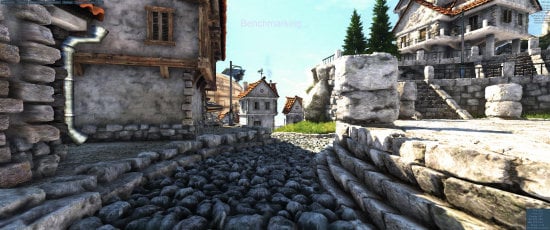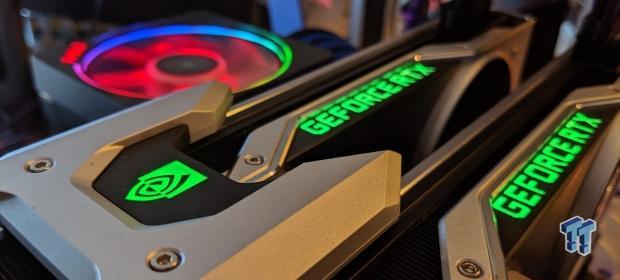Introduction & Fan Speed on NVLink/SLI
For the first time in a very long time I have switched over my main enthusiast rig to an AMD platform, moving away from my very familiar Intel platforms in the last decade. AMD has almost come out of nowhere with Ryzen and completely changed the game in the last few years, all culminating in the Zen 2 CPU and X570 chipset.
I have switched over to AMD's new Ryzen 7 3700X processor and ASRock X570 Taichi motherboard, with a super-crazy high-speed PCIe 4.0 NVMe M.2 SSD that pumps up to 5GB/sec and 16GB of G.SKILL Trident Z Royal DDR4-3200 memory.
I personally play on either my 32-inch monitor with a native 2560x1440 at 144Hz or the super-high-end 4K 144Hz display, and I consistently use the GeForce RTX 2080 Ti as my personal graphics card as it is the best. I have stuck with Intel CPUs because they have, at least until now, been superior for these types of gaming workloads.
So for me to enjoy my gaming sessions of Overwatch and Apex Legends at high FPS, I have to have a great platform to maintain that performance and the new Ryzen 7 3700X and X570 combo really kicks ass. I have moved from a mix of the Intel Core i7-8700K and Core i9-9900K processors to the new Ryzen 7 3700X and in Overwatch and Apex Legends, we have near equal performance.
The benchmarks will show a little otherwise, but for the most part I have been experiencing performance that I can't really tell between the 8700K and 9900K with the new 3700X. AMD has stepped it up to the point of enthusiasts and gamers alike are able to confidently buy a new Ryzen 3000 series CPUs and have a kick ass time.
Fan Speed on NVLink/SLI
Now that I've got a new high-end AMD Ryzen 7 3700X rig set up, I thought I would do some new testing with:
- NVIDIA GeForce RTX 2080 Ti in NVLink with STOCK fan speed
- NVIDIA GeForce RTX 2080 Ti in NVLink with 100% fan speed
- NVIDIA GeForce GTX 1080 Ti in SLI with STOCK fan speed
- NVIDIA GeForce GTX 1080 Ti in SLI with 100% fan speed
These tests show some interesting results, with up to 10% more performance when the fans are cranked up -- keeping those hot GPUs cooler allowing GPU Boost to do its thing on Pascal, and more optimal, on Turing.

| Today | 7 days ago | 30 days ago | ||
|---|---|---|---|---|
| Loading... | Loading... | |||
|
* Prices last scanned on 10/26/2024 at 3:15 pm CDT - prices may not be accurate, click links above for the latest price. We may earn an affiliate commission from any sales.
|
||||
New AMD Ryzen 7 3700X Testbed
Check Out My New Digs
This is the first enthusiast grade AMD CPU powered system that I have built for myself in many years, but with the arrival of AMD's next-gen Zen 2 architecture and its improvements in countless ways, it was time to make the switch.
AMD's new Ryzen 3000 series CPU family are the first processors from AMD that have just wiped the floor in so many ways -- I mean, we have 7nm while Intel is on 14nm. The new X570 boards have PCIe 4.0 connectivity, EVERY motherboard with an Intel chipset on the market has PCIe 3.0. IPC performance that either gets close to, matches, or beats the price-equivalent Intel CPU.
For an enthusiast, I want as many cores as you can throw at me but the gamer and ultra-enthusiast in me wants higher CPU clock speeds so I have every part in my machine either being the best on the market, or overclocking to past that point. I want to ensure I'm getting every frame I can get.
I've been running an Intel Core i7-8700K for the past few years until the Core i9-9900K arrived so I made the switch, and now into the Ryzen 7 3700X. Like the 9900K I still maintain my 8C/16T but I gain near identical gaming performance (which matters to me) but I get the new X570 chipset which has PCIe 4.0.
Sure, PCIe 4.0 is useless for graphics cards right now but for storage you can hit 5GB/sec which is insane, and I want that. I won't use it that often (to the full 5GB/sec speeds) but I damn well want it. I don't get into cars or any other main hobbies, PCs are my everything - I want it all. Haha.
AMD Ryzen 7 3700X + ASRock X570 Taichi
AMD's new Ryzen 7 3700X: 8C/16T, PCIe 4.0 ready, and all on 7nm - oh and the stock cooler kicks ass.
ASRock's new X570 Taichi motherboard is at the heart of our new Ryzen 7 3700X high-end GPU test bed.
Seriously, the G.SKILL Trident Z Royal DDR4 RAM is some of the best-looking RAM on the market.
The ASRock X570 Taichi motherboard has been serving me well through 100s of hours of benchmarking and gaming in the last few weeks, even with NVLink and SLI setups being punished on it.
The stock Wraith Prism RGB cooler that AMD provides with the retail Ryzen 7 3700X is all you need as AMD is squeezing as much as it can out of Precision Boost as it is, watercooling and AIO coolers won't provide you with crazier overclocks without really pushing things to their limits.
Cards Used: RTX 2080 Ti NVLink + GTX 1080 Ti SLI
I used the GeForce RTX 2080 Ti in NVLink and GeForce GTX 1080 Ti in SLI for this testing... but I will have another article that will cover the new GeForce RTX 2080 SUPER cards in NVLink, as well as the TITAN Xp cards in SLI.
I'll continue adding to this with Radeon RX Vega 64 in CrossFire to be tested soon, too.
Benchmarks - Synthetic
3DMark TimeSpy
3DMark TimeSpy Extreme

Heaven is an intensive GPU benchmark that really pushes your silicon to its limits. It's another favorite of ours as it has some great scaling for multi-GPU testing, and it's great for getting your GPU to 100% for power and noise testing.
Heaven - 1440p
Heaven - 4K
Benchmarks - 1440p
1440p Benchmarks
Middle-earth: Shadow of War is a sequel to the popular Shadow of Mordor, which was powered by the Lithtech engine. When cranked up to maximum detail, it will chew through your GPU and its VRAM like it's nothing.
You can buy Middle-earth: Shadow of War at Amazon.
Rainbow Six: Siege has been a strong entry into the franchise, popular for its realistic feel and great graphics. Stable as a rock for benchmarking, right up to 3440x1440 and 4K.
Shadow of the Tomb Raider is one of the latest games to join our graphics card benchmark lineup, with the game built using the Foundation engine as a base, the same engine in Rise of the Tomb Raider. Eidos Montreal R&D department made lots of changes to the engine during the development of Shadow of the Tomb Raider to make it one of the best-looking games out right now.
Benchmarks - 4K
4K Benchmarks
Middle-earth: Shadow of War is a sequel to the popular Shadow of Mordor, which was powered by the Lithtech engine. When cranked up to maximum detail, it will chew through your GPU and its VRAM like it's nothing.
You can buy Middle-earth: Shadow of War at Amazon.
Rainbow Six: Siege has been a strong entry into the franchise, popular for its realistic feel and great graphics. Stable as a rock for benchmarking, right up to 3440x1440 and 4K.
Shadow of the Tomb Raider is one of the latest games to join our graphics card benchmark lineup, with the game built using the Foundation engine as a base, the same engine in Rise of the Tomb Raider. Eidos Montreal R&D department made lots of changes to the engine during the development of Shadow of the Tomb Raider to make it one of the best-looking games out right now.
Final Thoughts
Final (Fan?) Thoughts
My testing on the GeForce RTX 2080 Ti in NVLink versus the older Pascal-based GeForce GTX 1080 Ti in SLI was an interesting one, with some major highlights at the right resolutions of the sheer power of the Turing GPU architecture and super-fast GDDR6 memory.
NVIDIA's new GeForce RTX 2080 Ti cards in NVLink shred the GTX 1080 Ti SLI setup in games like Shadow of War at 4K with a huge 110FPS average with stock fans, and even better 123FPS average when the fans are at 100%. This allows the card to stretch a little further and keep its high GPU clocks that much higher, as the card is staying cooler.
Note: I'm only testing the Founders Edition graphics cards here, with some NVLink setups from custom RTX cards coming soon. I will be updating these results with RTX 2070 SUPER and RTX 2080 SUPER cards in NVLink in the coming days and weeks, too. But the FE cards do run hotter than custom cards, so the results will definitely change.
Shadow of the Tomb Raider on the GTX 1080 Ti SLI is already good at 94-103FPS (fans at stock versus 100%) but the RTX 2080 Ti in NVLink boosts that to 125-131FPS (fans at stock versus 100%). RTX 2080 Ti in NVLink is what you'll want for some Big Format Gaming Display (BFGD) action on a huge 65-inch 4K 120Hz TV or the super-fast 4K 144Hz G-Sync gaming monitors for Shadow of the Tomb Raider.
I've got some interesting results with SLI and NVLink setup with Overwatch, something I need to spend some time with testing but I was getting virtually 100% scaling at 4K and even 8K. I can load the game up to maximum resolution scaling (200%) with maximum AA applied and it was pushing 98-100% GPU consumption on both cards. Those results are in the making now.
Wrapping up, increasing the fan speed on SLI and NVLink setups is an obvious one and a move that will net you some more performance and in some cases up to 10% more which is a big win for an already high-end setup.























